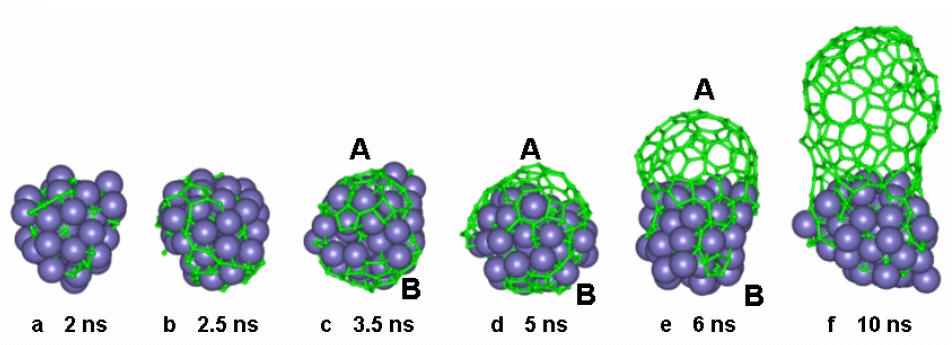MD Simulation of CNTs
Nucleation on Catalyst Particle Surface
 1. Potential
Energy Surface (PES)
1. Potential
Energy Surface (PES)
2.
SWNT nucleation on the surface of the catalyst particle (iron)

3.
More extensive discussions:
a.
The
Highly supersaturating nuclear process
b.
Catalyst
particle dependence SWNT growth
c.
Temperature
dependence SWNT growth
d.
Is the
temperature gradient indispensable for SWNT growth
e. A detailed Vapor-Liquid-Solid (VLS) model
3.
Prospects and possible future works
a.
Simulation
of multi-walled carbon nanotubes (MWNT) and
bamboo-like CNT
b. Understanding
the difference between SWNT, MWNT, bamboo-like CNT
c. Nucleation
of high-quality SWNT
d. Understanding
how the defects in the wall of SWNT and MWNT are fixed (Is catalyst particle
the most important?)
e.
Understanding
what determines the chirality of SWNT
f. Possible way of growing chirality selected SWNTs
g. Why binary catalysts are better than pure metals
h. How to design the best catalyst structure
i.
Simulation of SWNT nucleation in arc-discharge and laser ablation
cases
j.
Reveal the growth mechanism of other
one-dimensional nano-materials, especially the semi-conducting
nanowires made by catalytic CVD method (e.g., Si, Ge, ZnO
´)
Defects Formation on SWNT
|
|
|
|
|
Stone-Wales Defect (SW) |
Possible Stable Vacancy Defetct Structures |
Add-Atom Defect |

Low energy barrier diffusion of
vacancy defects in the SWNT wall


Position dependence formation energy
of Stone-Wales defects in a finite (5,5) SWNT




